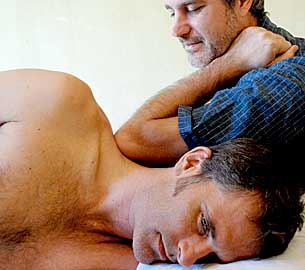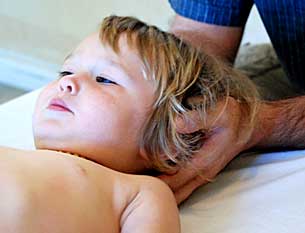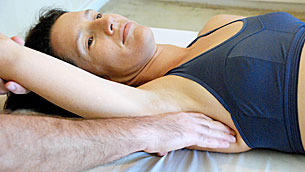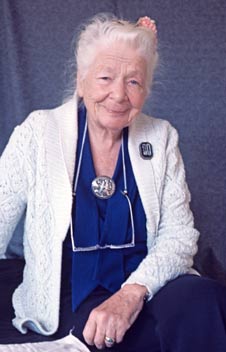|
Rolfing® Structural Integration is the science whereby the body’s
soft connective tissue, the fascia, is manipulated through an interactive process
of touch, movement and awareness to integrate the whole body in gravity. It brings
about more efficient movement and supports greater awareness of embodiment for the
client.

Rolfing usually involves ten sessions. Each session has specific goals which work
together resulting in an integrative approach that addresses the whole body.
A wide variety of highly skilled, gentle, slow, sometimes subtle, sometimes deep
touch is used to bring about changes in the soft connective tissue or fascia in
the body. As the fascia responds to this type of touch, the alignment of the whole
body improves.
In the process of Rolfing, new habits of the neuro-muscular kind are promoted giving
the client improved options of movement, posture, breathing, gesture and expression.
The effects of Rolfing are often described by clients as a feeling of lightness,
of being more upright and more comfortable in one’s body, of relief from long term
stress and tension and relief from long term aches and pains, and of greater ease
and range of movement, feeling free and more in the present.

Scientific research
has demonstrated that Rolfing creates a significant improvement in the quality of
life of people who have had the treatment. Not only do they have more efficient
use of muscles which allows the body to conserve energy, more economical and refined
patterns of movement are also created. Research also shows that Rolfing significantly
reduces chronic stress. For example, a study showed that Rolfing significantly reduced
the spinal curvature of subjects with lordosis (sway back); it also showed that
Rolfing enhances neurological functioning.


Dr. Ida P. Rolf
Dr. Ida P. Rolf, (1896-1979) the founder of Rolfing, received a PhD in biochemistry
from the Rockefeller Institute (later Columbia University).

Photo by Ron Thomson
Her basic question, ‘What conditions need to be present for the human body (structure)
to be integrated in gravity, and for the most efficient movement (function),’ led
to the development of Structural Integration by her from the 1920’s to her passing
in 1979. She presented her first trainings in the 1950’s, and it was only in the
early 1960’s that her work took root among practitioners as an original, comprehensive
system of working holistically with the whole person.

The Rolf Institute of
Structural Integration
Dr. Ida Rolf established the Rolf Institute of Structural Integration (www.rolf.org) in Boulder, Colorado, USA in 1971. This remains
the headquarters of the Rolfing community. In addition to the Rolf Institute, there
are Rolfing schools in Munich, Germany (European Rolfing Association www.rolfing.org ), Brazil (ABR), Japan (JRA), Australia
(ARA), and the newly established South African Rolfing Association that will host
the first Rolfing training in South Africa.
The first South African Rolfing training will be hosted in the picturesque University
Town of Stellenbosch.

Updated 26 November 2008, www.rolfing.co.za, editor: Eugenie Grobler
|

